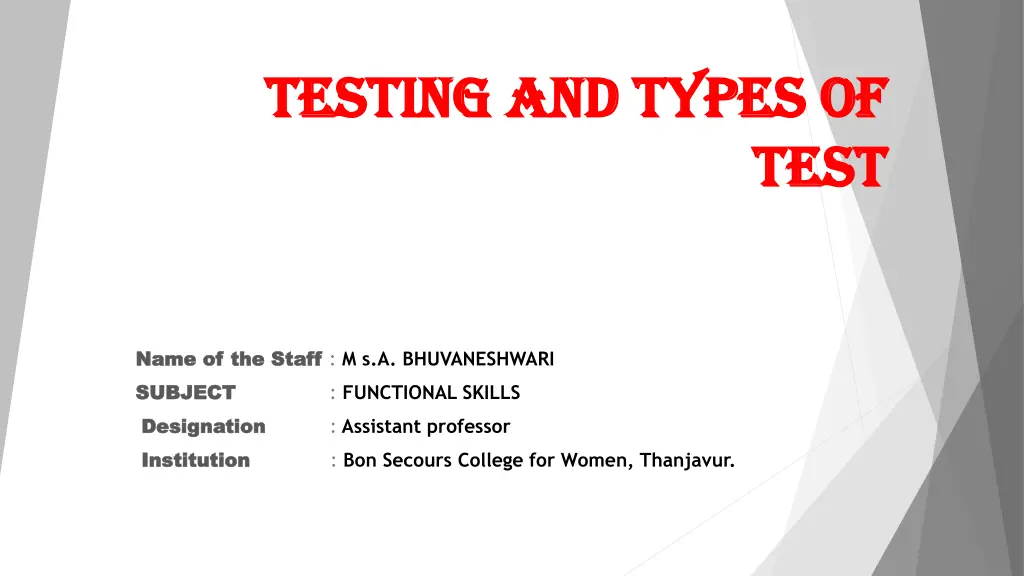
Types of Testing in Education - Direct vs. Indirect Methods
Explore the different types of testing methods used in education, including direct and indirect testing. Direct testing involves students performing skills directly, while indirect testing measures underlying abilities. Understand the distinctions between objective and subjective testing approaches and their impact on scoring. Enhance your knowledge of assessment strategies for evaluating student learning effectively.
Download Presentation

Please find below an Image/Link to download the presentation.
The content on the website is provided AS IS for your information and personal use only. It may not be sold, licensed, or shared on other websites without obtaining consent from the author. If you encounter any issues during the download, it is possible that the publisher has removed the file from their server.
You are allowed to download the files provided on this website for personal or commercial use, subject to the condition that they are used lawfully. All files are the property of their respective owners.
The content on the website is provided AS IS for your information and personal use only. It may not be sold, licensed, or shared on other websites without obtaining consent from the author.
E N D
Presentation Transcript
TESTING AND TYPES OF TESTING AND TYPES OF TEST TEST Name of the Staff Name of the Staff : M s.A. BHUVANESHWARI SUBJECT SUBJECT : FUNCTIONAL SKILLS Designation Designation : Assistant professor Institution Institution : Bon Secours College for Women, Thanjavur.
. OBJECTIVE TESTING . SUBJECTIVE TESTING INDIRECT TESTING TESTING DISCRETE POINT TESTING DIRECT TESTING INTEGRATIVE TESTING
DIRECT TESTING Testing is said to be direct when the student is required to perform directly the skill which we wish to measure. E.g. We ask students to write compositions if we want to know how well they can write compositions. We ask them to speak if we want to know how well they to speak if we want to know how well they can pronounce a language. Perform precisely the skill which is measured. The tasks and texts should be as authentic as possible. E.g. To know how students pronounce a language get them to speak.
INDIRECT TESTING Indirect testing attempts to measure the abilities which underline the skills in which underline the skills in which we are interested. E.g. we test pronunciation ability by asking students to identity parts of words which rhyme with each other. Measure the abilities underlying the skills. E.g. Sentence correction exercise an indirect measure of writing ability.
ATTRACTIONS DIRECT INDIRECT Create the conditions eliciting the behavior that the judgement is based on the assessment and interpretation of Ss performance is quite straifht forward. Test a representative sample of a finite number of abilities underlying a potentially indefinite large number of manifestation of them Helpful backwash effect
OBJECTIVE TESTING It doesn t require judgement on the part of the scorer because scoring here is subjective. The gradesin subjective testing depend on the impressions of the scorer. These impressions are not the same among different scorers. Scoring of a composition is an example of this kind of testing.
SUBJECTIVE TESTING It requires judgement on the part of the scorer because scoring because scoring here is subjective. The grades in subjective testing depends on the impression of the scorer. These impressions are not the same among different scorers. Scoring of a composition is an example of this kind of testing.
DISCRETE POINT TESTING It refers to the testing of one element at a time, item by item. This kind of testing is always indirect. Each testing involves a particular item. Testing particular grammatical structures is an example of this kind of testing. Discrete point testing refers to the testing of one element at a time, item by item. E.g. form of series of items, each testing a particular grammar structure.
INTEGRATIVE TESTING It includes many language elements in the completion of a task. It might involve writing a composition, taking notes while listening to a text and completing a close passage. Integrative testing requires a combination of many language elements in a completion of a task. E.g. Writing a composition taking a dictation or completing a cloze passage.
PROFICIENCY TESTS Proficiency tests measure people s ability in a language regardless of any training they may have had in that languages. Hughes. A (2003) Content: Base on a specification of what candidates have to be able to do in the language in order to be considered proficient (having sufficient command of the language for a purpose) E.g. test for a united nations transistor test for a course of study in a british university, test of arts, test of sciences Other proficiency tests are designed to show whether candidates have reached a certain standard with respect to certain specified abilities . Content : Base on detailed specification of what candidates can do E.g. the Cambridge examinations (FCE, CPE), the Oxford EFL examinations (Prelimnary and higher)
ACHIVEMENT TESTS Purposes: Measure how successful individual students, group of students, or the course them selves have been in achieving objectives Two kinds: Final achievement tests Progress achievement tests Advantages: Only contain what the learner has actually encountered affair test Disadvantages: A badly designed syllabus / badly chosen book Misleading results of rest Unreal achievement of the course objectives
TYPES OF ACHIVEMENT TESTS PROGRESS ACHIEVEMENT TESTS FINAL ACHIEVEMENT TESTS WRITTEN BY MINISTRIES OF EDUCATION, OFFICIAL EXAMINING BARDS, OR MEMBERS OF TEACHING INSTITUTIONS MEASURE THE PROGRESS THAT STUDENTS ARE MAKING THE TEST CONTENT CAN BE BASED ON A SYLLABUS STUDIED OR A BOOK TAEN DURING THE COURSE BASED ON SHORT-TERM OBJECTIVES SYLLABUS CONTENT APPROACH
DIAGNOSTIC TESTS PURPOSES: Identify learners strengths and weaknesses As cetain what learning still needsto take place It includes listening, speaking, reading, wrinting. ADVANTAGES: E.G. Analysis of a learner s performance in writing and speaking in terms of grammatical accuracy or linguistic appropriacy. Disadvantages: E.G. Difficulty in identifying whether a learner masters the present perfect/ past tense distinction
PLACEMENT TESTS Used to assign students to classes at different levels No one placement test will work for every institution The most successful one are those constructed for particular situations. To place students at the stage or class appropriate to their abilities




